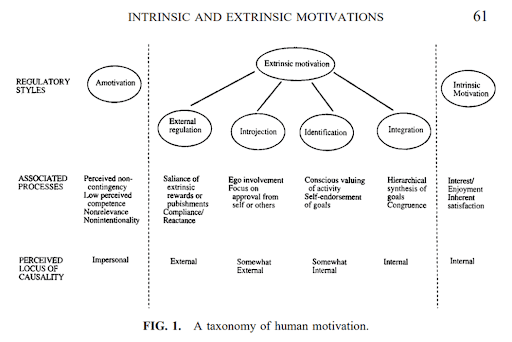Sean Fullerton is a former secondary physical education teacher and current Ph.D. student at the University of New Mexico in the Health, Exercise, and Sports Science Department. In this article, Sean explores motivational theories in physical education. Be on the lookout for lots of great content from Sean as he helps take the academic angle of physical education best practices.

Understanding Motivational Theories in Physical Education
Often the responsibility for motivation is placed solely on the student in physical education (PE) classes. Teachers can fall into the trap of believing certain students don’t have the disposition for physical activity or exercise, which is far from the truth. Several motivational theories in physical education have been researched and can provide some insight to what motivates students.
Motivation is simply what compels a person to do (or not do) something. Self-Determination Theory was first introduced in 1980 (Deci & Ryan, 1980). Deci and Ryan (1985, 2000) postulate that SDT is a motivational process in which an individual self-regulates their action depending on the degree of their need’s satisfaction. Additionally, Expectancy Value Theory, more updated, Situated Expectancy-Value Theory (Eccels & Wigfield, 2020), is another motivational theory that can be applied by teachers to foster a motivating environment for students.
Being aware of the motivational climate within the classroom is the teacher’s responsibility and understanding motivational theories and their application can improve student experiences in PE.
Free Professional Development For PE
From full courses to on-demand webinars, tap into the PLT4M classroom for continuing education opportunities for physical education teachers.
Motivational Theories in Physical Education: Self-Determination Theory
Self-Determination Theory was first proposed by Deci and Ryan (1980) and has been tested in PE since its induction. Self-Determination Theory distinguishes between different types of motivation “based on different reasons or goals that give rise to an action” (Deci & Ryan, 2000, p. 55). Motivation falls on a spectrum from amotivation (lack of motivation) to intrinsic motivation (interest, enjoyment, or inherent satisfaction), as seen in figure 1 (Deci & Ryan, 2000).

It is suggested that ideal motivation is intrinsic motivation, engaging in a behavior or activity because it is pleasurable, satisfying, and/or enjoyable. However, Ryan and Deci (2000) discuss that any form of extrinsic motivation is not always bad. Within extrinsic motivation falls external regulation (reward/punishment), Introjection (for approval from self or others), Identification (important/valuable), and Integration (congruent with goals).
As an example, an athlete may not necessarily enjoy waking up early for morning workouts, but they believe that doing so is important to earning a starting spot on the team. Through participation in the workouts they may begin to enjoy weightlifting because of how it makes them feel and helps them perform better.
Additionally, color coded T-shirts earned for lifting standards are examples of an external regulation (reward) and can provide incentive for hard work, dedication in the weight room, and status with teammates and coaches. With that being said, a person will be more determined if they are intrinsically motivated.
There are three main constructs within Self-determination Theory that are more likely to move an individual towards intrinsic motivation and when teachers or coaches are aware of these within their lesson design, they can enhance the motivation of their students.
Autonomy, Relatedness, and Competence
The three constructs to Self-Determination Theory are competence, relatedness, and autonomy.
Competence refers to the satisfaction of one’s ability and feelings to be effective in an activity (Deci & Ryan, 1985).
Relatedness is defined as the extent to which an individual feels connected to others, the senses of belonging both with one’s community and with other individuals (Ryan & Deci, 2000).
Autonomy is the degree to which an individual perceives themselves as the origin or source of behavior and as being responsible for the initiation of the behavior (Ryan & Deci, 2000).
These three tenants are central to increasing motivation for students in PE (Sun et al., 2017). When creating PE lessons, a teacher should be aware of these constructs and try to provide autonomy, develop competence, and promote relatedness between students and teacher to most likely increase self-determination (Sun et al., 2017).
Applying Self-Determination Theory in PE
Autonomy:
- Provide choices for students (i.e. multiple variations of an exercise, games or activities of varying difficulty, competitive vs. recreational options).
- Avoid framing activities as “required.”
- Allow students multiple options for a summative assessment (i.e. presentation, paper, or exam) or choices of project based learning.
Competence:
- Provide quality instruction and demonstrations, especially during new or novel movements/concepts.
- Check for understanding through formative assessments before progressing.
- Provide specific feedback routinely.
- Use modified forms of fitness assessments to match ability levels (e.g. modified pull-ups for upper body muscular strength endurance, see Brockport Physical Fitness Test Manual).
- Provide intra-task variation (i.e. multiple variations of a task focusing on the same motor skill).
Relatedness:
- Create a classroom environment that promotes positive relationships between peers and teacher.
- Create intentional groupings, whether heterogenous (same ability, knowledge level, or interest) or heterogenous (different ability, knowledge level, or interest) based on activity.
- Encourage students and always frame feedback positively.
- Develop relationships with students by learning about their interests, goals, and preferences.
- Use reciprocal and self-check teaching styles
Bonus Content! Related Motivational Materials for PE
In a PLT4M webinar, PE teacher Molly Collins broke down eight tips and strategies for motivating students in physical education. While Molly certainly doesn’t claim to have all the answers, she does provide great insights and ideas and has documented many of these strategies via social media. Let’s look at some of the strategies she is using in class throughout the school year.
Motivational Theories in Physical Education: Situated Expectancy-Value Theory
The Expectancy-Value Theory of achievement was first proposed by Eccles and colleagues (Eccles (Parsons) et al., 1983) and has been more recently labeled Situated Expectancy-Value Theory (Eccles & Wigfield, 2020). Eccles & Wigfield (2020) state that Situated Expectancy-Value Theory is both situationally and culturally bound, meaning motivation is dependent on the context and individual.
Eccles (Parsons) et al. (1983) postulated that “individuals’ expectancies for success and subjective task values are the most proximal psychological determinants of task and activity choice, performance, and engagement in the chosen activities” (p. 3). Eccles and Wigfield (2020) theorize that the overall value of a given task is composed of four main subjective task values: 1) intrinsic value 2) attainment value, 3) utility value, and 4) perceived cost.
Intrinsic Value, Attainment Value, Utility Value, Perceived Cost
Intrinsic value refers to interest or enjoyment, and this can be situational or personal. Increasing situational interest and enjoyment has the potential to lead to personal intrinsic value of a behavior activity, in that, if lessons and activities are routinely presented in an interesting and enjoyable way, an individual may develop a personal interest in that behavior/activity.
Attainment value refers to the importance of an activity. Establishing a why at the beginning of a school year, unit, or lesson, can provide context of an activity in one’s life.
Utility value refers to the usefulness of an activity. The need for individualization is paramount because what students find useful often differ and can be based on their level of competence.
Lastly, cost is what a person must omit in lieu of engaging in an activity. Cost can be time allocation, emotional cost, or even financial cost. Minimizing cost, specifically emotional cost, should be on the forefront of activity design in PE.
Applying Situated Expectancy-Value Theory in PE
Intrinsic Value (Interest/enjoyment):
- Create activities and design curriculum with student interest in mind, leave days or weeks open for “special topics” that are reserved for topics of student interest.
- Strive to find exercises and activities that students enjoy, finding pleasurable physical activities is the first step in exercise promotion.
- Introduce concepts in an interesting way that include novel information that has real world applications.
Attainment Value (Importance):
- Clearly discuss why exercise and physical activity is important and relevant to students (i.e. present developmentally appropriate literature about PE and correlation to academic performance, stress management, etc.)
- Create learning activities, especially early in the school year, that focus on the impact of physical activity and exercise on mental, emotional, and physical health and well-being.
- Explain why you are teaching something and why it is important in accomplishing the overall learning objective.
Utility Value (Usefulness):
- Create learning experiences that sequenced in a purposeful manner.
- Adapt to student learning, learning activities should be tailored to the pace at which students are learning and their ability levels.
- Learning outcomes should be relevant to students’ lives after high school (e.g. accessing a local exercise gym, participating on city league recreational sports teams, recreational lifetime activities, health enhancing physical activities, etc.)
Cost:
- Avoid putting students on display in front of peers.
- Promote cooperation over competition.
- Use class time efficiently, more is not necessarily better. Be concise with speaking and demonstrating time.
- Provide PE uniforms and proper footwear to students who cannot afford proper attire.
Free Professional Development For PE
From full courses to on-demand webinars, tap into the PLT4M classroom for continuing education opportunities for physical education teachers.
In creating a lesson, activity, or curriculum, it is worthwhile for a PE teacher to do so in an autonomy-supportive environment where competence and relatedness are developed. By designing learning activities that are useful, enjoyable, interesting, and important to students, they are more likely to be motivated to exercise and be physically active.
References
Deci, E. L., Ryan, R. M. (1980). Self-determination Theory: when mind mediates behavior. The Journal of Mind and Behavior. 1(1), 33-43.
Deci, E. L., & Ryan, R. M. (1985). Intrinsic motivation and self-determination in human behavior. New York: Plenum.
Eccles, J. S., & Wigfield, A. (2020). From expectancy-value theory to situated expectancy-value theory: A developmental, social cognitive, and sociocultural perspective on motivation. Contemporary Educational Psychology, 61, 101859. https://doi.org/10.1016/j.cedpsych.2020.101859
Eccles (Parsons), J. S., Adler, T. F., Futterman, R., Goff, S. B., Kaczala, C. M., Meece, J. L., et al. (1983). Expectancies, values, and academic behaviors. In J. T. Spence (Ed.). Achievement and achievement motivation (pp. 75–146). San Francisco, CA: W. H. Freeman.
Ryan, R. M., & Deci, E. L. (2000). Intrinsic and Extrinsic Motivations: Classic Definitions and New Directions. Contemporary Educational Psychology, 25(1), 54–67. https://doi.org/10.1006/ceps.1999.1020
Sun, H., Li, W., & Shen, B. (2017). Learning in Physical Education: A Self-Determination Theory Perspective. Journal of Teaching in Physical Education, 36(3), 277–291. https://doi.org/10.1123/jtpe.2017-0067
Other Articles From Sean Fullerton







